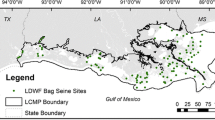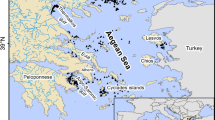Abstract
We show how a simple species distribution model can be used for the rapid estimation of potential yield and for the identification of suitable sites for farming of Tapes philippinarum in two North Adriatic lagoons (Caleri and Marinetta-Vallona, Italy) in the face of limited data. We used a two-part species distribution model with sediment type, hydrodynamism, dissolved oxygen, and salinity as predictors of T. philippinarum potential yield. The first model component uses logistic regression to identify the areas in which clams occur, while the second component uses a weighted geometric mean of suitability values to estimate the potential annual yield (kg m−2 year−1) for the sites where T. philippinarum is predicted to be present. We used site-specific yield data from Caleri and Marinetta-Vallona to estimate the weights of the geometric mean by constrained linear regression. We validated the two-part model on an independent set of yield data (R 2adj = 0.82), and we then estimated the spatial distribution of potential yield in the two lagoons. The calibration and application of a simple species distribution model are useful tools for objectively identifying the most suitable sites for farming of T. philippinarum in North Adriatic lagoons.




Similar content being viewed by others
References
Abbiati, M., M. Mistri, M. Bartoli, V. U. Ceccherelli, A. Colangelo, C. R. Ferrari, G. Giordani, C. Munari, M. Ponti, R. Rossi & P. Viaroli, 2010. Trade-off between conservation and exploitation of the transitional water ecosystems of the northern Adriatic. Chemistry and Ecology 26: 37–41.
Aguilar-Manjarrez, J. & L. G. Ross, 1995. Geographical information system (GIS) environmental models for aquaculture development in Sinaloa state, Mexico. Aquaculture International 3: 103–115.
Aguilar-Manjarrez, J., J. M. Kapetsky, & D. Soto, 2010. The potential of spatial planning tools to support the ecosystem approach to aquaculture. FAO Fisheries and Aquaculture Proceedings, Rome.
Akaike, H. A. I., 1974. A new look at the statistical model identification. IEEE Transactions on Automatic Control AC-19: 716–723.
Bartoli, M., D. Nizzoli, P. Viaroli, E. Turolla, G. Castaldelli, E. A. Fano & R. Rossi, 2001. Impact of Tapes philippinarum farming on nutrient dynamics and benthic respiration in the Sacca di Goro. Hydrobiologia 455: 203–221.
Breiman, L., 2001. Random forests. Machine Learning 45: 5–32.
Brugère, C., & N. Ridler, 2004. Global aquaculture outlook in the next decades: an analysis of national aquaculture production forecasts to 2030. FAO Fisheries Circular No. 1001 FIPP/C1001.
Buckley, L. B., M. C. Urban, M. J. Angilletta, L. G. Crozier, L. J. Rissler & M. W. Sears, 2010. Can mechanism inform species’ distribution models? Ecology Letters 13: 1041–1054.
Cho, Y., W.-C. Lee, S. Hong, H.-C. Kim & J. B. Kim, 2012. GIS-based suitable site selection using habitat suitability index for oyster farms in Geoje-Hansan Bay, Korea. Ocean & Coastal Management 56: 10–16.
D’Alpaos, L., & A. Defina, 1995. Modellazione matematica del comportamento idrodinamico di zone a barena solcate da una rete di canali minori. Istituto Veneto di Scienze, Lettere ed Arti, Venice, Italy.
Defina, A., 2000. Two-dimensional shallow flow equations for partially dry areas. Water Resources Research 36: 3251–3264.
Dormann, C. F., S. J. Schymanski, J. Cabral, I. Chuine, C. Graham, F. Hartig, M. Kearney, X. Morin, C. Römermann, B. Schröder & A. Singer, 2012. Correlation and process in species distribution models: bridging a dichotomy. Journal of Biogeography 12: 2119–2131.
Elith, J. & C. H. Graham, 2009. Do they? How do they? WHY do they differ? on finding reasons for differing performances of species distribution models. Ecography 32: 66–77.
Elith, J. & J. R. Leathwick, 2009. Species distribution models: ecological explanation and prediction across space and time. Annual Review of Ecology, Evolution, and Systematics 40: 677–697.
ESAV, 1990. Tapes philippinarum: biologia e sperimentazione. Venice, Italy.
FAO, 2010. The state of world fisheries and aquaculture. FAO, Rome.
Fielding, A. H. & J. F. Bell, 1997. A review of methods for the assessment of prediction errors in conservation presence/absence models. Environmental Conservation 24: 38–49.
Folk, R. L., 1980. Petrology and Sedimentary Rocks. Hemphill Press, Austin, TX.
Guo, X., S. E. Ford & F. Zhang, 1999. Molluscan aquaculture in China. Journal of Shellfish Research 18: 19–31.
Honey, K. T., J. H. Moxley, & R. M. Fujita, 2010. From rags to fishes: data-poor methods for fishery managers. In Managing Data-Poor Fisheries: Case Studies, Models & Solutions Conference. Berkeley, California: 159–184.
Kapetsky, J. M., J. M. Hill & L. D. Worthy, 1988. A geographical information system for catfish farming development. Aquaculture 68: 311–320.
Marinov, D., J. M. Zaldívar, A. Norro, G. Giordani & P. Viaroli, 2008. Integrated modelling in coastal lagoons: Sacca di Goro case study. Hydrobiologia 611: 147–165.
Melià, P., D. Nizzoli, M. Bartoli, M. Naldi, M. Gatto & P. Viaroli, 2003. Assessing the potential impact of clam rearing in dystrophic lagoons: an integrated oxygen balance. Chemistry and Ecology 19: 129–146.
Munari, C. & M. Mistri, 2007. Effect of copper on the scope for growth of clams (Tapes philippinarum) from a farming area in the Northern Adriatic Sea. Marine Environmental Research 64: 347–357.
Munari, C., R. Rossi, E. Turolla & M. Mistri, 2009. Estimating clam recruitment potential in a nursery area in the Sacca di Goro lagoon (Italy). Italian Journal of Zoology 76: 129–132.
Paesanti, F. & M. Pellizzato, 2000. Tapes philippinarum. Veneto Agricoltura, Legnaro: 73 pp.
Pastres, R., C. Solidoro, G. Cossarini, D. Melaku Canu & C. Dejak, 2001. Managing the rearing of Tapes philippinarum in the lagoon of Venice: a decision support system. Ecological Modelling 138: 231–245.
Pellizzato, M. & L. D. A. Ros, 2005. Clam farming quality as a management tool: a proposal based on recent studies in Northern Adriatic lagoons. Aquaculture International 13: 57–66.
Pranovi, F., F. Da Ponte, S. Raicevich & O. Giovanardi, 2004. A multidisciplinary study of the immediate effects of mechanical clam harvesting in the Venice Lagoon. ICES 61: 43–52.
Sbrenna, G. & D. Campioni, 1994. Gametogenic and spawning patterns of the Manila clams Tapes philippinarum (Bivalvia: Veneroida) in two lagoons of the river Po Delta, Italy. Journal of Shellfish Research 13: 37–46.
Silva, C., J. G. Ferreira, S. B. Bricker, T. A. DelValls, M. L. Martín-Díaz & E. Yáñez, 2011. Site selection for shellfish aquaculture by means of GIS and farm-scale models, with an emphasis on data-poor environments. Aquaculture 318: 444–457.
Solidoro, C., D. Melaku Canu & R. Rossi, 2003. Ecological and economic considerations on fishing and rearing of Tapes philippinarum in the lagoon of Venice. Ecological Modelling 170: 303–318.
Sorokin, I. I., O. Giovanardi, F. Pranovi & P. I. Sorokin, 1999. Need for restricting bivalve culture in the southern basin of the Lagoon of Venice. Hydrobiologia 400: 141–148.
Turolla, E., 2008. La venericoltura in Italia In Lovatelli, A., A. Farías, & I. Uriarte (eds), Estado actual del cultivo y manejo de moluscos bivalvos y su proyección futura: factores que afectan su sustentabilidad en América Latina. Taller Técnico Regional de la FAO, Rome: 177–188.
Vincenzi, S., G. Caramori, R. Rossi & G. A. De Leo, 2006a. A GIS-based habitat suitability model for commercial yield estimation of Tapes philippinarum in a Mediterranean coastal lagoon (Sacca di Goro, Italy). Ecological Modelling 193: 90–104.
Vincenzi, S., G. Caramori, R. Rossi & G. A. De Leo, 2006b. Estimating clam yield potential in the Sacca di Goro lagoon (Italy) by using a two-part conditional model. Aquaculture 261: 1281–1291.
Vincenzi, S., G. Caramori, R. Rossi & G. A. De Leo, 2007. A comparative analysis of three habitat suitability models for commercial yield estimation of Tapes philippinarum in a North Adriatic coastal lagoon (Sacca di Goro, Italy). Marine Pollution Bulletin 55: 579–590.
Vincenzi, S., M. Zucchetta, P. Franzoi, M. Pellizzato, F. Pranovi, G. A. De Leo & P. Torricelli, 2011. Application of a Random Forest algorithm to predict spatial distribution of the potential yield of Ruditapes philippinarum in the Venice lagoon, Italy. Ecological Modelling 222: 1471–1478.
Wenger, S. J. & J. D. Olden, 2012. Assessing transferability of ecological models: an underappreciated aspect of statistical validation. Methods in Ecology and Evolution 3: 260–267.
Acknowledgments
Simone Vincenzi is supported by an IOF Marie Curie Fellowship FP7-PEOPLE-2011-IOF for the project “RAPIDEVO” on rapid evolutionary responses to climate change in natural populations.
Author information
Authors and Affiliations
Corresponding author
Additional information
Handling editor: Pierluigi Viaroli
Rights and permissions
About this article
Cite this article
Vincenzi, S., De Leo, G.A., Munari, C. et al. Rapid estimation of potential yield for data-poor Tapes philippinarum fisheries in North Adriatic coastal lagoons. Hydrobiologia 724, 267–277 (2014). https://doi.org/10.1007/s10750-013-1742-z
Received:
Revised:
Accepted:
Published:
Issue Date:
DOI: https://doi.org/10.1007/s10750-013-1742-z




